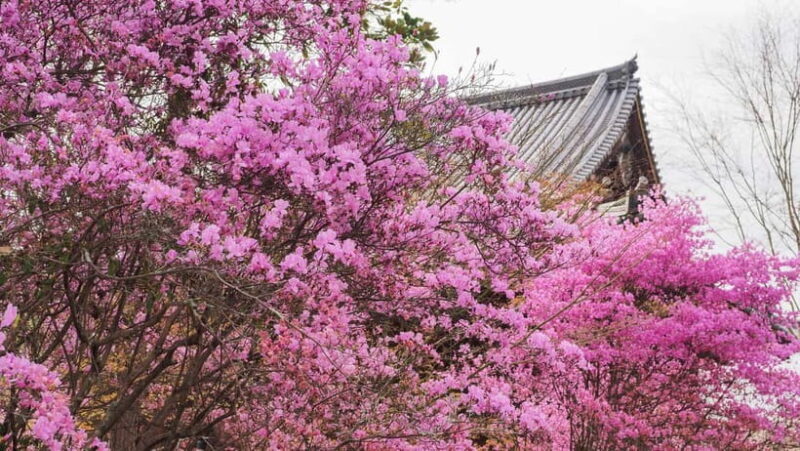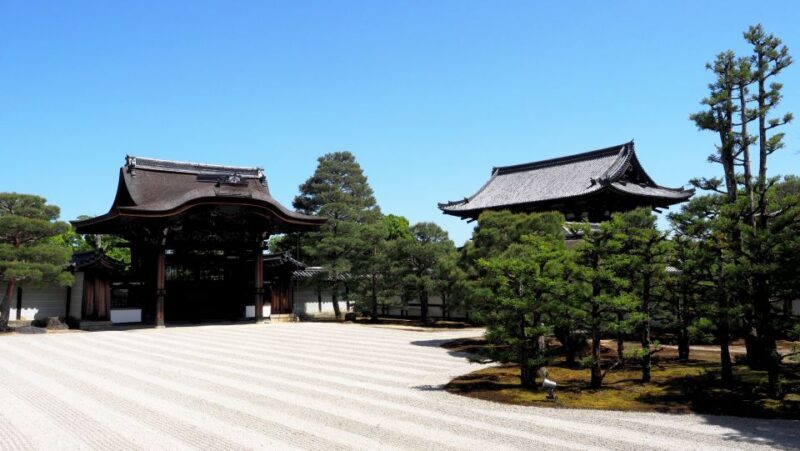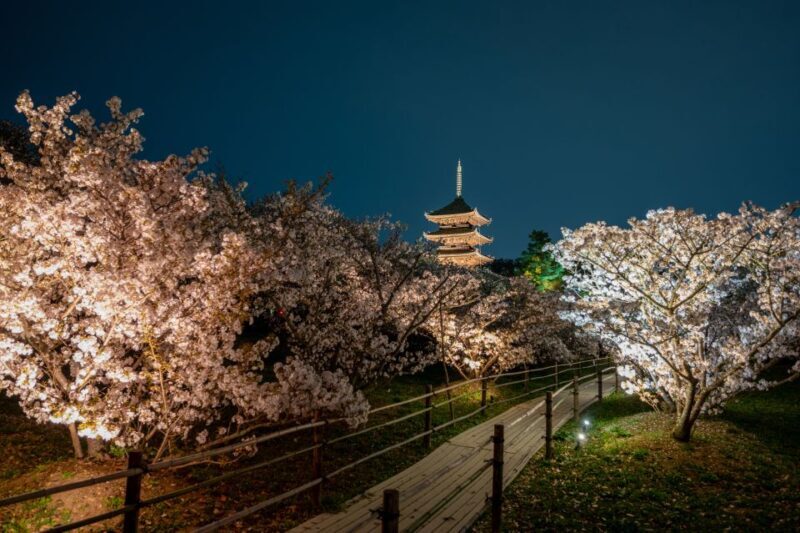If you’re seeking a chance to experience Kyoto’s spiritual atmosphere without the crowds that often flock to more famous sites, the Ninnaji Temple offers a peaceful escape. For just $9, you gain access to its historic grounds, the iconic five-story pagoda, and the Reihokan Museum, all set within a tranquil landscape that changes beautifully with each season. The entire experience takes about a couple of hours, making it a manageable yet enriching stop on your Kyoto itinerary.
What makes this visit particularly appealing are the late-blooming Omuro sakura cherry trees—a highlight in spring—and the serene gardens perfect for reflection any time of year. The opportunity to walk along the Omuro Pilgrimage course, a shorter version of Japan’s famous Shikoku Pilgrimage, adds a dimension of spiritual exploration that’s both accessible and meaningful.
One potential consideration is that during peak cherry blossom season, visitors will need an additional fee to access certain areas, which helps fund the preservation of the beautiful Omuro Sakura. Also, while the ticket covers most areas, check if you want to visit special exhibits or areas that might require separate tickets. This is an excellent choice for those seeking authentic, less touristy experiences or a peaceful retreat to appreciate Japan’s cultural treasures.
Travelers who love quiet, authentic experiences and are interested in Japan’s religious art or natural beauty will find this tour especially rewarding. It’s perfect for those who prefer exploring at a leisurely pace and want to avoid the crowds typically found at more famous Kyoto temples.
Key Points

- Affordable entry fee for a deep dive into Kyoto’s spiritual sites.
- Beautiful gardens and architecture that change with the seasons, from cherry blossoms to snow.
- Cultural treasures housed in the Reihokan Museum, including artifacts and statues.
- Peaceful atmosphere ideal for reflection and photography.
- Accessible pilgrimage route that offers a spiritual walk without the long commitment.
- Great value for the price, especially for those interested in history and nature.
A Detailed Look at Ninnaji Temple: What You Can Expect

When you purchase a ticket for Ninnaji Temple, you’re opening the door to a slice of Kyoto’s spiritual and cultural life that’s often overlooked amid the more crowded sights. This temple was founded in 888 AD, making it one of the oldest in Kyoto, and it remains a place of profound tranquility and beauty. The five-story pagoda is a standout, offering an impressive silhouette against the sky — a classic image of Kyoto that’s worth capturing.
The grounds are extensive and well-maintained, with elegant gardens and pathways that wind around historic structures. We loved the way the gardens change throughout the year, from vibrant autumn leaves to the snow-dusted landscapes, giving every visit a new feel. One visitor noted, “A quiet, less crowded temple that offers a tour of a beautiful garden and access to the general grounds where the main temple and a few other architectural structures stand,” which sums up the authentic, calming experience you can expect.
Beyond the main buildings, the Reihokan Museum houses priceless artifacts—ancient manuscripts, statues, and relics that tell stories of Japan’s spiritual past. If you select this option, you’ll get a chance to see these treasures, making your visit both visually and intellectually enriching.
The Omuro Pilgrimage Course
A particular highlight is the Omuro Pilgrimage course—a shorter, accessible route inspired by Japan’s famous Shikoku Pilgrimage. It’s designed to be completed in about two hours, surrounded by nature sounds and seasonal scenery, offering a peaceful walk that’s spiritually meaningful without requiring days of commitment. In spring, you’ll be treated to late-blooming cherry blossoms, while summer and fall bring vibrant foliage. In winter, the snow-covered gardens and Goten Palace offer a serene, almost meditative experience.
Practical Details and Visitor Tips
The opening hours are from 9 AM to 5 PM March through November, and until 4:30 PM in winter, so plan your visit accordingly. The ticket booth closes 30 minutes before the temple itself, so arrive a little earlier to avoid disappointment.
During the cherry blossom season, an additional fee is charged to access the areas around the Omuro Sakura, helping fund their preservation. Keep in mind that disability certificate holders can enter free of charge, but need to ask at the ticket counter.
The ticket price of $9 is quite reasonable given the wealth of cultural sights you get to enjoy—you’re paying for access to a historical temple complex, its gardens, museum, and scenic pilgrimage route.
Authentic, Peaceful, and Educational: Who Will Enjoy This?

This experience is ideal for travelers who prefer quiet, less touristy spots and wish to enjoy Japan’s spiritual side without the crowds. It’s perfect for those interested in Japanese art, architecture, and nature, offering a meaningful atmosphere for reflection. Families, solo travelers, or couples looking for a peaceful cultural outing will find this a valuable addition to their Kyoto visit.
People who appreciate seasonal beauty, like cherry blossoms or snow, will love visiting at different times of the year. The affordable price makes it accessible, and the comprehensive access to gardens, buildings, and museum artifacts means you get a lot of value for your money.
More Great Tours NearbyIn-Depth Review: Why Choose Ninnaji Temple?

The Beauty of the Grounds and Architecture
We loved the way the temple buildings blend seamlessly with the natural environment, creating a peaceful atmosphere perfect for strolling and contemplating. The five-story pagoda is particularly striking, standing out as a symbol of Kyoto’s architectural prowess. Its silhouette against the sky offers a perfect photo opportunity. Visitors frequently comment on the stunning views and the serenity that pervades the site.
The Gardens and Seasonal Changes
The gardens are a highlight year-round, providing a lush backdrop for your visit. In spring, the Omuro sakura cherry trees bloom late, offering a unique sight for those visiting after the more famous cherry blossom season. During autumn, fiery reds and yellows paint the landscape, which many reviewers describe as a must-see. In winter, a blanket of snow transforms the gardens into a silent retreat, perfect for those seeking calm and solitude.
The Museum and Cultural Artifacts
The Reihokan Museum is often praised for its well-preserved collection. As one visitor, Anan, shared, “The exhibition provides a remarkable journey through Japan’s spiritual and cultural heritage. No crowds, just a peaceful environment to admire ancient manuscripts and statues.” This aspect makes the ticket a good value, especially for those eager to explore Japan’s religious art without the busy crowds of other temples.
The Omuro Pilgrimage Experience
Walking the Omuro Pilgrimage course offers more than just a walk; it’s a spiritual experience that connects you with Japan’s long-standing tradition of pilgrimage. Surrounded by nature sounds and seasonal scenery, it’s a gentle way to reflect and enjoy Kyoto’s landscape.
Practical Tips for Visiting
- Arrive early or later in the day to avoid the busiest times.
- Check if you want to see the museum or special exhibits, which may require additional tickets.
- Be aware of the seasonal fee during cherry blossom season if you want to access the Omuro Sakura viewing areas.
- For those with mobility issues, note that disability certificate holders get free entry, making accessibility easier.
The Overall Experience and Value
At just $9, this ticket offers a comprehensive glimpse into Kyoto’s spiritual sites. It’s a great value, considering the range of sights and experiences included. Visitors consistently praise the calm atmosphere and knowledgeable guides, making it a worthwhile stop for those seeking authenticity and serenity.
The Sum Up

Choosing to visit Ninnaji Temple with this entry ticket means investing in a peaceful, beautiful, and culturally enriching experience. It’s perfect for travelers who want to escape the crowds, enjoy seasonal scenery, and enjoy Japan’s spiritual art and architecture. Whether you’re a history buff, a nature lover, or simply looking for a calming retreat, Ninnaji offers genuine value and memorable sights for a modest price.
If you favor authentic Kyoto experiences away from the hustle and bustle of popular spots, this is a choice you won’t regret. The combination of stunning vistas, historic architecture, and peaceful gardens makes it a highlight that balances beauty and tranquility. It’s a site that rewards patience and a quiet spirit—perfect for those who want to connect with Japan’s cultural soul.
FAQs

Is this ticket valid for all areas of Ninnaji Temple?
Yes, with this entry ticket you can access all areas of the temple complex, including the gardens, main buildings, and the Reihokan Museum if you choose that option.
How much does the ticket cost?
The ticket is priced at $9 per person, which is quite reasonable given the variety of sights included.
Are there any additional fees I should know about?
Yes, during cherry blossom season, an extra fee is required if you want to view the Omuro Sakura cherry blossoms in certain areas. This fee helps support the preservation of the trees.
What are the opening hours?
From March to November, the temple is open from 9 AM to 5 PM, and from December to February, hours are from 9 AM to 4:30 PM.
Is there accessibility for visitors with disabilities?
Yes, those with a physical disability certificate can enter free of charge, but it’s best to ask at the ticket counter.
How long should I plan to spend at Ninnaji?
Most visitors spend around two hours exploring the gardens, buildings, and museum—perfect for a relaxing break in your Kyoto day.
Can I purchase tickets in advance?
Yes, you can reserve your ticket and even pay later, offering flexibility in planning your trip.
Is this tour suitable for children or families?
Absolutely, especially if your family appreciates calm, scenic, and culturally enriching environments.
In all, Ninnaji Temple’s entry ticket offers a balanced mix of history, nature, and spirituality, making it a valuable addition to any Kyoto journey. Its affordability, tranquil setting, and cultural treasures make it a choice well worth considering, especially if you’re yearning for a genuine, less crowded Japanese temple experience.
You can check availability for your dates here: